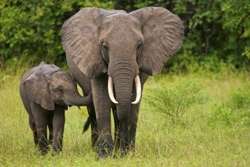New research challenges evolutionary theory

(PhysOrg.com) -- New research from the University of Reading overturns conventional views on the nature of evolution, arguing that mammals did not develop into their many different forms in one early and rapid burst of evolution but rather found many different evolutionary routes.
It is widely assumed that species often diverge rapidly early in their evolution, and that this is followed by a longer, drawn-out period of slower evolutionary fine-tuning.
Explanations for this pattern suppose that mammals moved into a largely unoccupied niche and geographical space as they came to be the dominant vertebrate group on Earth. Then, as time went on, niche space and unexplored geographical regions became scarce, reducing opportunities for diversification.
However, the research led by Professor Mark Pagel, in conjunction with Dr Chris Venditti and Dr Andrew Meade, shows that there is no necessary connection between the rates at which new species emerge and the underlying rates of evolution of their features. Thus, the majority of mammal species, including two of the most prevalent orders of mammals (the rodents and bats), have no history of substantial and sustained increases in the rates at which they evolve.
Instead, these species achieved high rates of ‘speciation' or the production of new species, even though their rates of evolution were close to normal for mammals.
By comparison, some of the highest average rates of change occur in one of the least numerous groups. The Proboscidea, including elephants and sea cows, evolve on average 4.6-fold faster than the mammalian norm. The results highlight natural selection's role as a precise sculptor of mammalian size diversity, able to produce rapid body size changes seemingly at will.
Professor Pagel said: "It has long been believed mammals underwent a burst of body-size evolution that occurred early in their history and that this was followed by a gradual slowdown towards the present. However, we find that the processes that give rise to the morphological diversity of this class of animals are far more free to vary than previously considered. Niches do not seem to fill up, and diversity seems to arise whenever, wherever and at whatever rate it is advantageous. We find that natural selection has found multiple different routes to producing the current diversity of sizes."
‘Multiple routes to mammalian diversity', by Chris Venditti (now at University of Hull), Andrew Meade and Mark Pagel, is published in Nature on Wednesday October 19.
More information: DOI:10.1038/nature10516
Provided by University of Reading

















